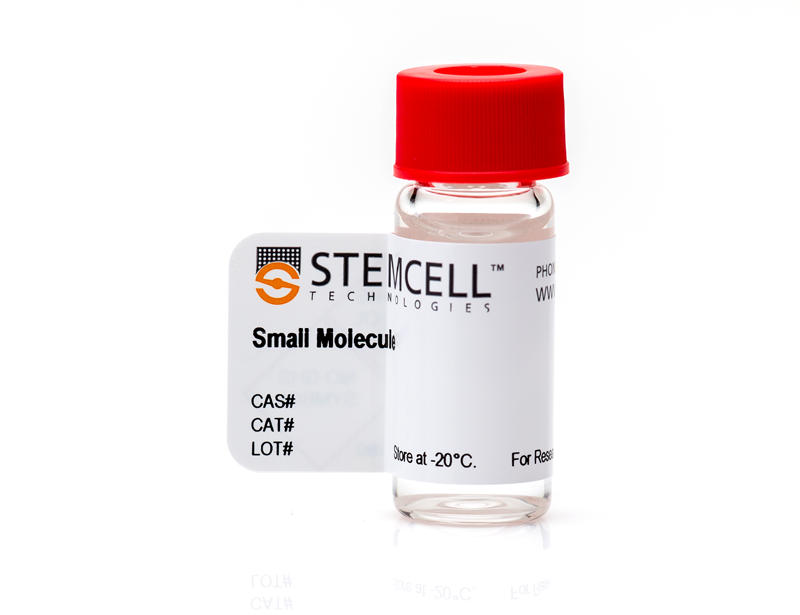概要
Rho Kinase Inhibitor IV is a selective and potent inhibitor of Rho-associated coiled-coil containing protein kinase 2 (ROCK2; IC₅₀ = 11.8 nM; Tamura et al.). It is a glycyl analog of Fasudil (Catalog #73662) with increased specificity for ROCK2 (Tamura). Rho Kinase Inhibitor IV is more potent than other ROCK inhibitors, including Y-27632 (Ki = 220 nM) and Fasudil (IC₅₀ = 158 nM). It shows good specificity for ROCK2 compared to other kinases such as calcium/calmodulin-dependent kinase type II (IC₅₀ = 2.57 μM), PKG (IC₅₀ = 2.35 μM), Aurora A (IC₅₀ = 3.26 μM), or PKA or PKC (IC₅₀ ≥ 10 μM each). ROCK1 and ROCK2 act downstream of the G protein Rho to regulate actin-myosin turnover and dynamics, and play an important role in stem cell renewal, smooth muscle contraction, cell adhesion, and proliferation (Narumiya et al.; Olson; Watanabe et al.). This product is supplied as the dihydrochloride salt of the molecule.
DIFFERENTIATION
· Promotes neurite growth in primary rat neuronal cultures (Al-Ali et al.).
· Impairs primitive gut tube development including midgut elongation in Xenopus embryos (Reed et al.).
DISEASE MODELING
· Reduces intraocular pressure in a rabbit model of glaucoma (Tamura et al.).
DIFFERENTIATION
· Promotes neurite growth in primary rat neuronal cultures (Al-Ali et al.).
· Impairs primitive gut tube development including midgut elongation in Xenopus embryos (Reed et al.).
DISEASE MODELING
· Reduces intraocular pressure in a rabbit model of glaucoma (Tamura et al.).
技术资料
| Document Type | 产品名称 | Catalog # | Lot # | 语言 |
|---|---|---|---|---|
| Product Information Sheet | Rho Kinase Inhibitor IV (Dihydrochloride) | 73802, 73804 | All | English |
| Safety Data Sheet | Rho Kinase Inhibitor IV (Dihydrochloride) | 73802, 73804 | All | English |
数据及文献
Publications (6)
ACS chemical biology 2013 MAY
Morphogenesis of the primitive gut tube is generated by Rho/ROCK/myosin II-mediated endoderm rearrangements.
Abstract
Abstract
During digestive organogenesis, the primitive gut tube (PGT) undergoes dramatic elongation and forms a lumen lined by a single-layer of epithelium. In Xenopus, endoderm cells in the core of the PGT rearrange during gut elongation, but the morphogenetic mechanisms controlling their reorganization are undetermined. Here, we define the dynamic changes in endoderm cell shape, polarity, and tissue architecture that underlie Xenopus gut morphogenesis. Gut endoderm cells intercalate radially, between their anterior and posterior neighbors, transforming the nearly solid endoderm core into a single layer of epithelium while concomitantly eliciting radially convergent" extension within the gut walls. Inhibition of Rho/ROCK/Myosin II activity prevents endoderm rearrangements and consequently perturbs both gut elongation and digestive epithelial morphogenesis. Our results suggest that the cellular and molecular events driving tissue elongation in the PGT are mechanistically analogous to those that function during gastrulation�
ACS chemical biology 2013 MAY
A ROCK inhibitor permits survival of dissociated human embryonic stem cells.
Abstract
Abstract
Poor survival of human embryonic stem (hES) cells after cell dissociation is an obstacle to research, hindering manipulations such as subcloning. Here we show that application of a selective Rho-associated kinase (ROCK) inhibitor, Y-27632, to hES cells markedly diminishes dissociation-induced apoptosis, increases cloning efficiency (from approximately 1% to approximately 27%) and facilitates subcloning after gene transfer. Furthermore, dissociated hES cells treated with Y-27632 are protected from apoptosis even in serum-free suspension (SFEB) culture and form floating aggregates. We demonstrate that the protective ability of Y-27632 enables SFEB-cultured hES cells to survive and differentiate into Bf1(+) cortical and basal telencephalic progenitors, as do SFEB-cultured mouse ES cells.
ACS Chemical Biology 2013 MAY
Chemical Interrogation of the Neuronal Kinome Using a Primary Cell-Based Screening Assay
Abstract
Abstract
A fundamental impediment to functional recovery from spinal cord injury (SCI) and traumatic brain injury is the lack of sufficient axonal regeneration in the adult central nervous system. There is thus a need to develop agents that can stimulate axon growth to re-establish severed connections. Given the critical role played by protein kinases in regulating axon growth and the potential for pharmacological intervention, small molecule protein kinase inhibitors present a promising therapeutic strategy. Here, we report a robust cell-based phenotypic assay, utilizing primary rat hippocampal neurons, for identifying small molecule kinase inhibitors that promote neurite growth. The assay is highly reliable and suitable for medium-throughput screening, as indicated by its Z'-factor of 0.73. A focused structurally diverse library of protein kinase inhibitors was screened, revealing several compound groups with the ability to strongly and consistently promote neurite growth. The best performing bioassay hit robustly and consistently promoted axon growth in a postnatal cortical slice culture assay. This study can serve as a jumping-off point for structure activity relationship (SAR) and other drug discovery approaches toward the development of drugs for treating SCI and related neurological pathologies.
ACS chemical biology 2013 MAY
Applications for ROCK kinase inhibition.
Abstract
Abstract
ROCK kinases, which play central roles in the organization of the actin cytoskeleton, are tantalizing targets for the treatment of human diseases. Deletion of ROCK I in mice revealed a role in the pathophysiological responses to high blood pressure, and validated ROCK inhibition for the treatment of specific types of cardiovascular disease. To date, the only ROCK inhibitor employed clinically in humans is fasudil, which has been used safely in Japan since 1995 for the treatment of cerebral vasospasm. Clinical trials, mostly focusing on the cardiovascular system, have uncovered beneficial effects of fasudil for additional indications. Intriguing recent findings also suggest significant potential for ROCK inhibitors in the production and implantation of stem cells for disease therapies.
ACS chemical biology 2013 MAY
Rho signaling, ROCK and mDia1, in transformation, metastasis and invasion.
Abstract
Abstract
The Rho subgroup of the Rho GTPases consisting of RhoA, RhoB and RhoC induces a specific type of actin cytoskeleton and carry out a variety of functions in the cell. mDia and ROCK are downstream effectors of Rho mediating Rho action on the actin cytoskeleton; mDia produces actin filaments by nucleation and polymerization and ROCK activate myosin to cross-link them for induction of actomyosin bundles and contractility. mDia is potentially linked to Rac activation and membrane ruffle formation through c-Src-induced phosphorylation of focal adhesion proteins, and ROCK antagonizes this mDia action. Thus, cell morphogenesis, adhesion, and motility can be determined by the balance between mDia and ROCK activities. Though they are not oncogenes by themselves, overexpression of RhoA and RhoC are often found in clinical cancers, and RhoC has been repeatedly identified as a gene associated with metastasis. The Rho-ROCK pathway is implicated in Ras-mediated transformation, the amoeboid movement of tumor cells in the three-dimensional matrix, and transmigration of tumor cells through the mesothelial monolayer. On the other hand, the Rho-mDia1 pathway is implicated in Src-mediated remodeling of focal adhesions and migration of tumor cells. There is also an indication that the Rho pathway other than ROCK is involved in Src-mediated induction of podosome and regulation of matrix metalloproteases. Thus, Rho mediates various phenotypes of malignant transformation by Ras and Src through its effectors, ROCK and mDia.
ACS chemical biology 2013 MAY
Development of specific Rho-kinase inhibitors and their clinical application.
Abstract
Abstract
Hexahydro-1-(isoquinoline-5-sulfonyl)-1H-1,4-diazepine, HA-1077, is a known selective inhibitor of Rho-kinase. Although its IC(50) value against Rho-kinase is more than 10 times lower than those for kinases such as PKA, PKB, PKC, PKG, MLCK, CaMKII and others, the molecule still retains relative potent inhibition activities against these kinases. In order to produce highly specific Rho-kinase inhibitors, several HA-1077 analogs were synthesized and their kinase inhibition properties evaluated. (S)-Hexahydro-1-(4-ethenylisoquinoline-5-sulfonyl)-2-methyl-1H-1,4-diazepine was found to be a potent Rho-kinase inhibitor. The IC50 value against Rho-kinase was 6 nM, while those against other kinases remained at almost the same level as that of HA-1077. Furthermore, we designed HA-1077 analogs on the basis of the complex structure of PKA and HA-1077. Amongst these, (S)-hexahydro-4-glycyl-2-methyl-1-(4-methylisoquinoline-5-sulfonyl)-1H-1,4-diazepine and other glycine derivatives were found to be highly specific Rho-kinase inhibitors. These Rho-kinase specific inhibitors were applied to rabbit ocular hypertensive models and were shown to reduce intraocular pressure. These results demonstrate that the new 5-isoquinolinesulfonylamides are not only potent ROCK selective compounds, but are also useful compounds for clinical applications.

 网站首页
网站首页





